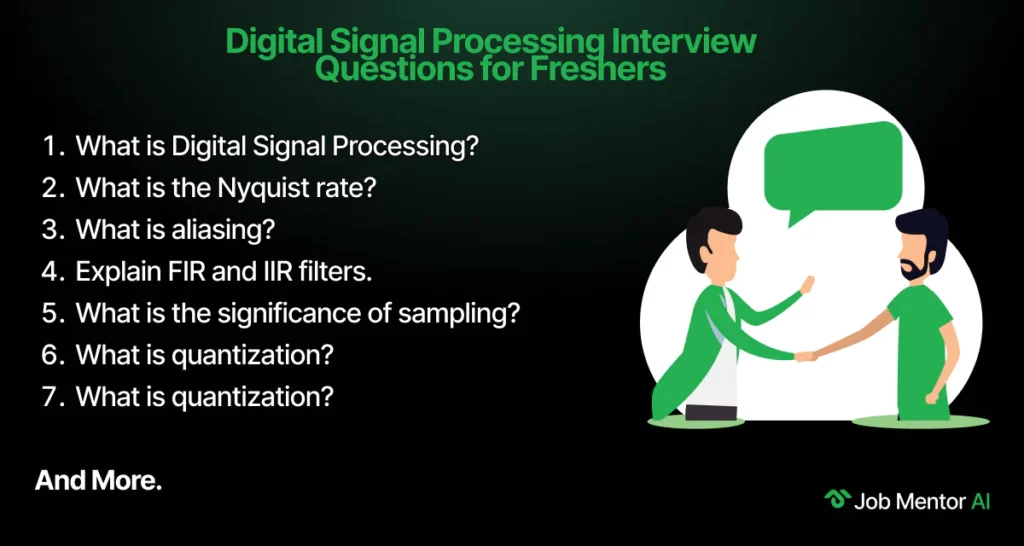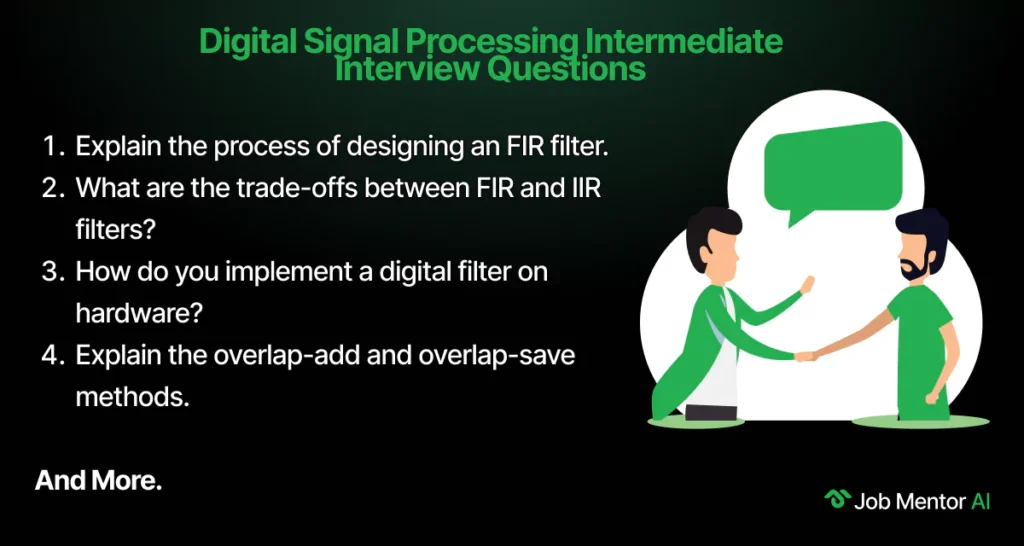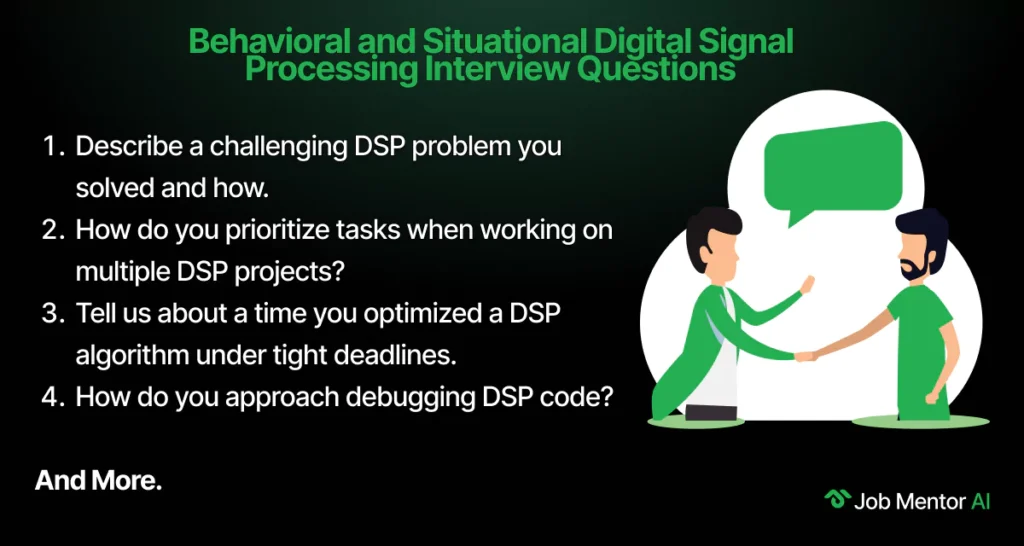Top 40 Digital Signal Processing Interview Questions
Preparing for a Digital Signal Processing (DSP) interview? Whether you’re a fresher or a seasoned expert, mastering the right questions and answers is essential to securing your ideal role. This comprehensive guide covers the top 40 must-know DSP interview questions, including fundamental concepts, technical challenges, behavioral scenarios, and advanced topics that interviewers frequently explore.

What is Digital Signal Processing?
Digital Signal Processing (DSP) is the manipulation and analysis of signals, such as audio, video, temperature, or sensor data, using digital techniques. Unlike analog signal processing, which handles continuous signals, DSP converts these signals into a digital format so they can be processed by computers or specialized hardware. DSP enables tasks like filtering noise, compressing data, enhancing images, and extracting important features from raw signals. It plays a crucial role in modern electronics, communications, audio and video technology, biomedical engineering, and many other fields where accurate and efficient signal manipulation is essential.
40 Must-Know Digital Signal Processing Interview Questions
Digital Signal Processing Interview Questions for Freshers
- What is Digital Signal Processing?
- What is the Nyquist rate?
- What is aliasing?
- Explain FIR and IIR filters.
- What is the significance of sampling?
- What is quantization?
- What are discrete-time signals?
- What is the Z-transform?
- What is the difference between time domain and frequency domain?
- What is the Fast Fourier Transform (FFT)?
Digital Signal Processing Intermediate Interview Questions
- Explain the process of designing an FIR filter.
- What are the trade-offs between FIR and IIR filters?
- How do you implement a digital filter on hardware?
- Explain the overlap-add and overlap-save methods.
- What is multirate DSP and where is it used?
- How do you reduce spectral leakage?
- Explain the concept of phase response in digital filters.
- What is a Hilbert transform?
- How does windowing affect FFT results?
- Describe the use of adaptive filters
Digital Signal Processing Experienced-Level Interview Questions
- How do you optimize DSP algorithms for real-time processing?
- Explain fixed-point vs floating-point DSP implementations.
- How do you handle finite word length effects?
- Describe advanced adaptive filtering techniques.
- How would you design a DSP system for noise cancellation?
- What methods do you use for DSP algorithm validation?
- How does DSP integrate with machine learning?
- Explain spectral estimation techniques.
- What is the significance of phase unwrapping in practical DSP?
- How do you implement multichannel DSP systems?
Behavioral and Situational Digital Signal Processing Interview Questions
- Describe a challenging DSP problem you solved and how.
- How do you prioritize tasks when working on multiple DSP projects?
- Tell us about a time you optimized a DSP algorithm under tight deadlines.
- How do you approach debugging DSP code?
- Have you ever had to explain a complex DSP concept to a non-technical stakeholder? How?
- Describe your experience working with cross-functional teams on DSP projects.
- How do you stay updated with the latest DSP technologies?
- Tell about a situation where you improved system performance using DSP.
- How do you manage errors or unexpected results in DSP outputs?
- Describe a time when you had to learn a new DSP tool or technique quickly.
Digital Signal Processing Interview Questions for Freshers
This section of Digital Signal Processing interview questions for freshers covers essential DSP interview questions tailored for freshers, helping you grasp the basics clearly. For additional help AI Interview Answer Generator helps you craft personalized answer to boost your interview preparation further.

1. What is Digital Signal Processing?
Digital Signal Processing (DSP) involves manipulating signals in their digital form to improve or extract information. It converts analog signals into digital data, enabling processing using algorithms for applications such as audio enhancement, image processing, telecommunications, and control systems.
2. What is the Nyquist rate?
The Nyquist rate is the minimum sampling frequency required to accurately capture all information from an analog signal without distortion. It is defined as twice the highest frequency component in the signal.
3. What is aliasing?
Aliasing occurs when a signal is sampled below its Nyquist rate, causing different frequency components to become indistinguishable or “fold” onto each other, resulting in signal distortion.
4. Explain FIR and IIR filters.
FIR filters have a finite-duration impulse response and are inherently stable, often with linear phase response. IIR filters have an infinite-duration impulse response and can be more computationally efficient but may introduce phase distortion and instability.
5. What is the significance of sampling?
Sampling converts continuous-time signals into discrete-time signals, making it possible to process signals digitally. It forms the foundation for digital signal processing.
6. What is quantization?
Quantization maps continuous amplitude values into a finite set of levels during analog-to-digital conversion, introducing quantization noise or error.
7. What are discrete-time signals?
Discrete-time signals are sequences of data points indexed by time, obtained by sampling continuous signals.
8. What is the Z-transform?
The Z-transform converts discrete-time signals into the frequency domain for easier analysis of linear systems and filter design.
9. What is the difference between time domain and frequency domain?
The time domain shows signal amplitude versus time, while the frequency domain shows signal amplitude versus frequency components.
10. What is the Fast Fourier Transform (FFT)?
FFT is a fast algorithm to compute the Discrete Fourier Transform, converting signals from the time domain to the frequency domain efficiently.
Explore More Helpful Resources
Digital Signal Processing Intermediate Interview Questions
Digital Signal Processing interview questions dives into your practical knowledge and analytical thinking. To complement your technical preparation, AI Cover Letter Generator can create a standout cover letter tailored to any role and help land your next opportunity.

11. Explain the process of designing an FIR filter.
Designing an FIR filter starts with defining the filter requirements, including the cutoff frequencies, filter order (which affects sharpness and complexity), and the desired response type (low-pass, high-pass, band-pass, or band-stop). You then select a suitable window function (like Hamming, Hanning, or Blackman) to shape the filter’s frequency response and minimize side lobes. The window method involves multiplying the ideal filter’s impulse response by the window function to obtain the actual FIR coefficients. After computing the coefficients, you analyze the filter’s frequency and phase response to ensure it meets specifications, making adjustments if necessary.
12. What are the trade-offs between FIR and IIR filters?
FIR filters offer guaranteed stability and linear phase response, preserving the waveform shape, which is critical in applications like data communications and audio. However, achieving sharp cutoffs requires high filter order, increasing computational load. IIR filters are computationally efficient with lower order but may suffer from phase distortion and potential instability, which can be problematic in sensitive systems.
13. How do you implement a digital filter on hardware?
Digital filters are commonly implemented on DSP processors, microcontrollers, or FPGAs. The filter algorithm, such as convolution or recursive difference equations, is programmed in software or hardware description languages (e.g., VHDL). Real-time constraints often require optimization strategies, like fixed-point arithmetic, loop unrolling, or parallel processing, to meet speed and power requirements.
14. Explain the overlap-add and overlap-save methods.
Both are block processing techniques for efficiently performing long convolutions using FFTs. The overlap-add method divides the input signal into overlapping blocks, computes convolution on each block separately, then adds the overlapping parts. The overlap-save method also uses overlapping blocks but discards the corrupted parts of the convolution result. These methods reduce computation time compared to direct convolution, enabling faster filtering of long signals.
15. What is multirate DSP and where is it used?
Multirate DSP involves processing signals at multiple sampling rates within a system to optimize resources. Common operations include decimation (downsampling to reduce data rate) and interpolation (upsampling to increase data rate). It’s widely used in audio processing (e.g., changing sampling rates), communications (e.g., modulation/demodulation), and efficient filter bank design.
16. How do you reduce spectral leakage?
Spectral leakage occurs when the sampled signal does not contain an integer number of periods within the FFT window, causing energy from a signal’s frequency component to “leak” into adjacent frequencies. This leakage distorts the true frequency content and reduces spectral accuracy. To minimize this effect, window functions such as Hamming, Hann, or Blackman are applied to the signal before performing the FFT. These windows smoothly taper the edges of the signal to zero, reducing discontinuities at the boundaries.
17. Explain the concept of phase response in digital filters.
Phase response refers to how the phase of each frequency component of an input signal is shifted as it passes through a digital filter. A linear phase filter delays all frequency components by the same amount, preserving the shape of the waveform and avoiding distortion, which is crucial in applications like audio and communications. In contrast, nonlinear phase filters introduce varying delays across frequencies, causing phase distortion and altering the original signal’s waveform.
18. What is a Hilbert transform?
The Hilbert transform is a mathematical operation that shifts the phase of every frequency component of a real-valued signal by 90 degrees. It is used to create the analytic signal, which combines the original signal (as the real part) with its Hilbert transform (as the imaginary part). This complex-valued analytic signal is useful for extracting the signal’s envelope, instantaneous amplitude, and phase information. Applications of the Hilbert transform include modulation techniques in communications, envelope detection in signal analysis, and instantaneous frequency estimation, making it a valuable tool in advanced DSP.
19. How does windowing affect FFT results?
Windowing is applied to a signal before performing an FFT to reduce spectral leakage by tapering the edges of the sampled data smoothly to zero. This reduces discontinuities at the window boundaries that cause leakage, resulting in a cleaner frequency spectrum. However, applying a window also widens the main lobe of the frequency response, which decreases frequency resolution and can make closely spaced signals harder to distinguish. Different windows (e.g., Hamming, Hann, Blackman) provide different trade-offs between leakage reduction and resolution.
20. Describe the use of adaptive filters.
Adaptive filters are dynamic filters that automatically adjust their filter coefficients in real time based on the characteristics of the input signal and a desired response. This self-adjustment allows them to minimize the error between the actual output and the target signal, making them highly effective in environments where signal characteristics change over time. Common applications include noise cancellation, where unwanted noise is continuously reduced, echo suppression in communication systems, and system identification where the filter models an unknown system.
Digital Signal Processing Experienced-Level Interview Questions
Digital Signal Processing Experienced-Level Interview Questions demands mastery of both theoretical concepts and practical implementations and integration with emerging technologies like machine learning. For a smarter preparation AI Interview Intelligence analyzes your interview performance to provide personalized feedback.

21. How do you optimize DSP algorithms for real-time processing?
Optimizing DSP algorithms for real-time processing requires reducing computational complexity and ensuring efficient use of hardware resources. Common strategies include replacing computationally intensive Discrete Fourier Transforms (DFT) with Fast Fourier Transforms (FFT), which drastically reduce processing time. Fixed-point arithmetic is often preferred over floating-point to improve speed and decrease power consumption. Additionally, techniques such as loop unrolling, pipelining, and parallel processing on specialized DSP processors or FPGAs can enhance throughput.
22. Explain fixed-point vs floating-point DSP implementations.
Aspect
Fixed-Point DSP
Floating-Point DSP
Number Representation
Uses a fixed number of decimal places
Uses a mantissa and exponent for a wide dynamic range
Processing Speed
Faster due to simpler arithmetic
Slower because of more complex arithmetic
Power Consumption
Lower power consumption, ideal for resource-constrained devices
Higher power consumption
Precision
Requires careful scaling to avoid overflow/underflow
Requires careful scaling to avoid overflow/underflow
Design Complexity
More complex due to need for manual scaling and saturation handling
Simpler algorithm development
Typical Use Cases
Embedded systems, real-time applications with tight constraints
High-performance computing, desktop DSP applications
23. How do you handle finite word length effects?
Finite word length effects arise because digital systems represent numbers with limited bits, introducing quantization noise, round-off errors, and potentially causing limit cycles in recursive filters. To mitigate these effects, designers can increase the bit width of data paths and filter coefficients to improve precision. Scaling inputs and coefficients carefully prevents overflow and maintains signal fidelity. Techniques such as noise shaping and dithering help distribute quantization noise more evenly. Moreover, designing filters with inherent stability and robustness to coefficient quantization minimizes the impact of finite word length on system performance.
24. Describe advanced adaptive filtering techniques.
Advanced adaptive filtering techniques go beyond the basic Least Mean Squares (LMS) algorithm to improve convergence speed and accuracy. Recursive Least Squares (RLS) algorithms offer faster convergence by minimizing the weighted least squares error but at higher computational cost. Kalman filters extend adaptive filtering to dynamic systems by estimating states recursively in the presence of noise. Neural-network-based adaptive filters leverage machine learning to model complex, nonlinear systems where traditional linear adaptive filters fail.
25. How would you design a DSP system for noise cancellation?
Designing a DSP system for noise cancellation involves capturing a reference noise signal correlated with the unwanted noise in the primary input. An adaptive filter then models the noise path and generates an estimate of the noise, which is subtracted from the primary signal to produce a cleaner output. The system must operate in real time with minimal latency, requiring efficient adaptive algorithms like LMS or RLS. Stability and convergence speed are critical to ensure consistent noise reduction without distorting the desired signal..
26. What methods do you use for DSP algorithm validation?
Validation of DSP algorithms combines simulation and real-world testing to ensure correctness and performance. Initial testing involves simulating algorithms using synthetic and real datasets to verify functional accuracy and frequency response. Bit-true simulation replicates fixed-point arithmetic behavior to catch quantization errors early. Hardware-in-the-loop testing integrates the algorithm with physical hardware to observe real-time performance and identify bottlenecks. Profiling on target DSP hardware measures execution time and resource usage, ensuring the algorithm meets system constraints.
27. How does DSP integrate with machine learning?
DSP and machine learning complement each other by combining signal preprocessing with intelligent decision-making. DSP algorithms extract meaningful features from raw signals, such as spectral coefficients, wavelet transforms, or statistical moments, which serve as inputs to machine learning models for classification or regression tasks. In some cases, DSP functions like filtering or noise reduction are embedded within neural network architectures to enhance model robustness.
28. Explain spectral estimation techniques.
Spectral estimation techniques aim to estimate the power distribution of a signal over frequency, providing insight into its frequency content even when noisy or limited data are available. Periodograms provide a basic estimate by computing the squared magnitude of the FFT but suffer from high variance. Welch’s method improves this by averaging periodograms over overlapping data segments, reducing variance and noise effects. Parametric methods like Autoregressive (AR) modeling fit a model to the data, offering higher resolution for short data sets.
29. What is the significance of phase unwrapping in practical DSP?
Phase unwrapping is the process of removing discontinuities (jumps of ±2π radians) from phase measurements to create a continuous phase curve. It is essential because raw phase data from Fourier transforms or interferometry are typically wrapped within the interval [-π, π], which can distort phase-based analysis. A continuous phase signal allows accurate reconstruction of time delays, distance measurements, and modulation parameters.
30. How do you implement multichannel DSP systems?
Implementing multichannel DSP systems involves handling multiple data streams from sensors or inputs simultaneously while maintaining synchronization. This requires efficient data acquisition hardware and precise timing control to ensure samples across channels are aligned. Processing can be performed concurrently or in parallel, often using multicore DSP processors or FPGA architectures. Inter-channel dependencies such as crosstalk or correlation need to be managed carefully to avoid artifacts. Memory and bus architectures must support high data throughput to prevent bottlenecks.
Behavioral and Situational Digital Signal Processing Interview Questions
Behavioral and Situational Digital Signal Processing interview questions evaluates your problem-solving skills, teamwork, communication, and adaptability traits vital for success in DSP roles beyond technical knowledge. Practicing these questions helps you prepare thoughtful, structured responses. For additional practice, AI Mock Interview Practice can simulate real interview scenarios and prepare for an interview.

31. Describe a challenging DSP problem you solved and how.
In one project, I encountered sensor data corrupted with heavy noise, which traditional filtering methods failed to clean effectively. After researching adaptive filtering techniques, I implemented an LMS adaptive filter that adjusted its coefficients dynamically in response to changing noise conditions. This solution significantly improved the signal-to-noise ratio and stabilized the output. The adaptive nature of the filter allowed the system to maintain accuracy even when noise characteristics shifted during operation, which was critical for reliable real-time data analysis.
32. How do you prioritize tasks when working on multiple DSP projects?
When managing multiple DSP projects, I start by evaluating each task’s deadlines, complexity, and overall impact on the project goals. I break larger tasks into smaller milestones, focusing first on those that unblock others or have the highest priority. I use project management tools to keep track of progress and frequently communicate updates with team members and stakeholders to ensure alignment. This approach helps me maintain focus on critical activities, balance workload effectively, and adjust priorities dynamically if unexpected issues arise.
33. Tell us about a time you optimized a DSP algorithm under tight deadlines.
During a critical product demo, I noticed the processing latency was causing noticeable delays in system response. To address this, I analyzed the FFT implementation and replaced floating-point calculations with fixed-point arithmetic, which is faster on embedded processors. I also applied loop unrolling and optimized memory access patterns to reduce overhead. These changes collectively decreased processing time by about 40%, enabling the system to meet real-time requirements without compromising output quality.
34. How do you approach debugging DSP code?
My debugging process begins with validating inputs and outputs at every stage of the DSP pipeline using visualization tools such as MATLAB plots or logic analyzers. I methodically isolate modules to identify where unexpected behavior originates. I use carefully designed test vectors and compare outputs against known references to pinpoint errors. When necessary, I leverage simulation environments to reproduce issues consistently. Collaboration with peers often provides new perspectives, accelerating problem resolution and ensuring robust, error-free implementations.
35. Have you ever had to explain a complex DSP concept to a non-technical stakeholder? How?
Yes, I have found that simplifying complex DSP concepts using relatable analogies helps bridge the understanding gap. For example, I explained filtering by comparing it to removing static from a radio signal, emphasizing the practical effect rather than the technical details. I also use visual aids like simplified graphs and animations to illustrate how signals change after processing. I avoid jargon and encourage questions to ensure the stakeholder feels comfortable and fully understands the value of the DSP techniques being applied.
36. Describe your experience working with cross-functional teams on DSP projects.
I have frequently worked alongside hardware engineers, software developers, and product managers to ensure smooth integration of DSP algorithms into larger systems. I participate in regular design reviews and cross-team meetings to align objectives, clarify requirements, and identify potential interface issues early. This collaboration helps prevent last-minute integration challenges and ensures that firmware and hardware are developed in sync with DSP software. Clear communication and mutual respect have been essential to delivering successful projects on schedule.
37. How do you stay updated with the latest DSP technologies?
I stay current by subscribing to leading DSP journals and newsletters, attending webinars and industry conferences, and participating actively in online forums and communities. I also allocate time for self-directed learning, experimenting with new algorithms, tools, and frameworks through side projects. This continuous learning mindset helps me adapt to evolving technologies and incorporate state-of-the-art techniques into my work, ensuring that my skills remain relevant and competitive in the fast-changing DSP landscape.
38. Tell about a situation where you improved system performance using DSP.
In a recent project, I designed and implemented an advanced noise reduction algorithm that enhanced audio clarity by approximately 30%. By carefully analyzing the noise characteristics and adapting filter parameters in real time, the system effectively suppressed unwanted background noise without distorting the desired signal. This improvement led to a noticeably better user experience and increased product appeal in a competitive market. The project highlighted how thoughtful DSP design can directly translate into tangible business benefits.
39. How do you manage errors or unexpected results in DSP outputs?
When encountering unexpected DSP outputs, I first review the entire signal processing chain, checking data integrity at each stage and verifying that inputs meet assumptions. I compare results with simulations and known test cases to isolate inconsistencies. If the issue persists, I collaborate with team members to brainstorm possible causes, including hardware faults or algorithmic errors. I also document findings and corrective steps meticulously to prevent recurrence and improve future designs. This systematic approach ensures quick and reliable troubleshooting.
40. Describe a time when you had to learn a new DSP tool or technique quickly.
When my team decided to adopt a new DSP development framework, I proactively dedicated extra hours to study online tutorials, read documentation, and experiment with sample projects. I focused on understanding the framework’s core features and how it integrated with our existing toolchain. By applying this knowledge to a pilot project, I was able to contribute effectively within a week. This experience reinforced the importance of self-motivation and hands-on learning when adapting to new technologies in fast-paced environments.
Key Takeaways
- DSP is vital in modern electronics and communications.
- Understanding core DSP concepts is essential for interviews.
- Practical knowledge of algorithms and implementation is highly valued.
- Behavioral skills complement technical expertise in DSP roles.
- Real-time processing and optimization are critical skills for advanced DSP positions.
- Familiarity with both hardware and software aspects enhances DSP problem-solving ability.
- Continuous learning and staying updated with emerging DSP technologies are important for career growth.
Questions to Ask the Interviewer
- What DSP tools and platforms does your team primarily use?
- Can you describe a typical DSP project lifecycle here?
- How does this role interact with other engineering teams?
- What are the main challenges your DSP team is currently facing?
- Are there opportunities for further training or certification in DSP?
- How does the company support innovation and experimentation in DSP projects?
- What performance metrics or KPIs are used to evaluate success in this role?
- Are there upcoming projects involving new DSP technologies or applications?
Top 60 Azure DevOps Interview Questions 2025
Table of Contents
Recommended Resources

Top 40 Database Administrator Interview Questions

Top 40 Digital Signal Processing Interview Questions

Machine Learning Engineer Interview Questions

Top 70 Accounting Assistant Interview Questions and Answers

Top 40+ Account Executive Interview Questions

Network Engineer Interview Questions



